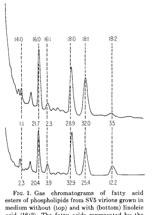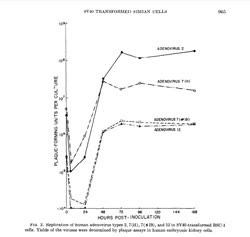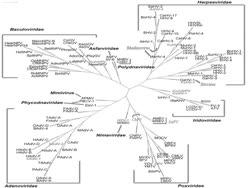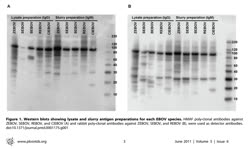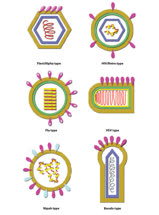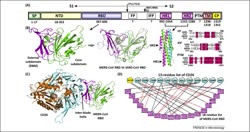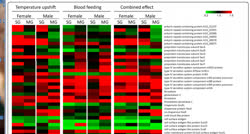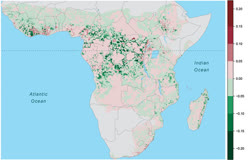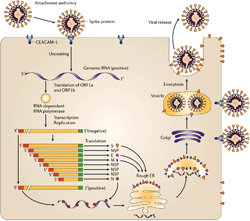|
Plasma membrane lipids and parainfluenza virus assembly Hans-DieterKlenk Purnell W.Choppin
|
|
Susceptibility to superinfection of simian cells transformed by SV40 Characterization of a stable line of African green monkey kidney cells (BSC-1) transformed by SV40 was undertaken to determine whether these cells were resistant to superinfection by the homologous virus. The transformed cells were shown to synthesize the SV40-specific tumor antigen, the surface antigen, and the transplantation rejection antigen; SV40 capsid antigen was not detected. Infectious SV40 could not be recovered even after fusion of the transformed cells with cells susceptible to SV40 replication. Human adenovirus types 2, 7, and 12 replicated in the cells (but not in the parental, nontransformed cells), indicating either that the portion of the SV40 genome which aids the replication of human adenoviruses in simian cells was present in the transformed cells or that an adenovirus-sensitive cell population had been selected. However, SV40 was unable to replicate in the transformed cells, although simian adenovirus 7 and herpes viruses types 1 and 2 replicated in both parental and transformed cells.
|
|
Whole genome molecular phylogeny of large dsDNA viruses using composition vector method Abstract |
|
Association of KIR2DS1 and KIR2DS3 with fatal outcome in Ebola virus infection Zaďre ebolavirus (ZEBOV) infection rapidly outruns the host's immunity and leads to death within a week. Fatal cases have been associated with an aberrant innate, proinflammatory immune response followed by a suppressed adaptive response leading to the rapid depletion of peripheral NK cells and lymphocytes. A critical role for NK cells has been suggested but not elucidated. In this genetic study, we investigated the association of KIR genotype with disease outcome by comparing genotypes of a Gabonese control population, IgG+ contacts, survivors, and fatalities of ZEBOV infection. We showed that the activating KIR2DS1 and KIR2DS3 genes associate with fatal outcome in Ebola virus infection. In addition, this study brings supplemental evidence in favor of the specificity of the IgG+ contact population. The outcome of fulminating Ebola virus infection could depend in part on the host's inherited KIR gene repertoire. This supports a key role for KIRs in disease susceptibility to infections. |
|
Serologic Cross-Reactivity of Human IgM and IgG Antibodies to Five Species of Ebola Virus Five species of Ebola virus (EBOV) have been identified, with nucleotide differences of 30–45% between species. Four of these species have been shown to cause Ebola hemorrhagic fever (EHF) in humans and a fifth species (Reston ebolavirus) is capable of causing a similar disease in non-human primates. While examining potential serologic cross-reactivity between EBOV species is important for diagnostic assays as well as putative vaccines, the nature of cross-reactive antibodies following EBOV infection has not been thoroughly characterized. In order to examine cross-reactivity of human serologic responses to EBOV, we developed antigen preparations for all five EBOV species, and compared serologic responses by IgM capture and IgG enzyme-linked immunosorbent assay (ELISA) in groups of convalescent diagnostic sera from outbreaks in Kikwit, Democratic Republic of Congo (n = 24), Gulu, Uganda (n = 20), Bundibugyo, Uganda (n = 33), and the Philippines (n = 18), which represent outbreaks due to four different EBOV species. For groups of samples from Kikwit, Gulu, and Bundibugyo, some limited IgM cross-reactivity was noted between heterologous sera-antigen pairs, however, IgM responses were largely stronger against autologous antigen. In some instances IgG responses were higher to autologous antigen than heterologous antigen, however, in contrast to IgM responses, we observed strong cross-reactive IgG antibody responses to heterologous antigens among all sets of samples. Finally, we examined autologous IgM and IgG antibody levels, relative to time following EHF onset, and observed early peaking and declining IgM antibody levels (by 80 days) and early development and persistence of IgG antibodies among all samples, implying a consistent pattern of antibody kinetics, regardless of EBOV species. Our findings demonstrate limited cross-reactivity of IgM antibodies to EBOV, however, the stronger tendency for cross-reactive IgG antibody responses can largely circumvent limitations in the utility of heterologous antigen for diagnostic assays and may assist in the development of antibody-mediated vaccines to EBOV |
|
Structure Unifies the Viral Universe Is it possible to meaningfully comprehend the diversity of the viral world? We propose that it is. This is based on the observation that, although there is immense genomic variation, every infective virion is restricted by strict constraints in structure space (i.e., there are a limited number of ways to fold a protein chain, and only a small subset of these have the potential to construct a virion, the hallmark of a virus). We have previously suggested the use of structure for the higher-order classifi- cation of viruses, where genomic similarities are no longer observable. Here, we summarize the arguments behind this proposal, describe the current status of structural work, highlighting its power to infer common ancestry, and discuss the limitations and obstacles ahead of us. We also reflect on the future opportunities for a more concerted effort to provide high-throughput methods to facilitate the large-scale sampling of the virosphere. |
|
Antigenic Subversion: A Novel Mechanism of Host Immune Evasion by Ebola Virus In addition to its surface glycoprotein (GP1,2), Ebola virus (EBOV) directs the production of large quantities of a truncated glycoprotein isoform (sGP) that is secreted into the extracellular space. The generation of secreted antigens has been studied in several viruses and suggested as a mechanism of host immune evasion through absorption of antibodies and interference with antibody-mediated clearance. However such a role has not been conclusively determined for the Ebola virus sGP. In this study, we immunized mice with DNA constructs expressing GP1,2 and/or sGP, and demonstrate that sGP can efficiently compete for anti-GP12 antibodies, but only from mice that have been immunized by sGP. We term this phenomenon “antigenic subversion”, and propose a model whereby sGP redirects the host antibody response to focus on epitopes which it shares with membrane-bound GP1,2, thereby allowing it to absorb anti-GP1,2 antibodies. Unexpectedly, we found that sGP can also subvert a previously immunized host's anti-GP1,2 response resulting in strong cross-reactivity with sGP. This finding is particularly relevant to EBOV vaccinology since it underscores the importance of eliciting robust immunity that is sufficient to rapidly clear an infection before antigenic subversion can occur. Antigenic subversion represents a novel virus escape strategy that likely helps EBOV evade host immunity, and may represent an important obstacle to EBOV vaccine design. |
|
Bat-to-human: spike features determining ‘host jump’ of coronaviruses SARS-CoV, MERS-CoV, and beyond Highlights
|
|
Did a Single Amino Acid Change Make Ebola Virus More Virulent? Gof in 2014 Ebola
A mutation in the Ebola virus glycoprotein arose early during the 2013-2016 epidemic and dominated the viral population. Two studies by Diehl et al. and Urbanowicz et al. now reveal that this mutation is associated with higher infectivity to human cells, representing the clearest example of Ebola's functional adaptation to human hosts. |
|
Virulence genes of Rickettsia rickettsii are differentially modulated by upshift or blood-feeding in tick midgut and salivary glands Abstract |
|
Minimally Symptomatic Infection in an Ebola ‘Hotspot’: A Cross-Sectional Serosurvey By using ELISA to measure Zaire Ebola virus antibody concentrations, we identified a significant number of individuals with previously undetected EBOV infection in a ‘hotspot’ village in Sierra Leone, approximately one year after the village outbreak. The findings provide further evidence that Ebola, like many other viral infections, presents with a spectrum of clinical manifestations, including minimally symptomatic infection. These data also suggest that a significant portion of Ebola transmission events may have gone undetected during the outbreak. Further studies are needed to understand the potential risk of transmission and clinical sequelae in individuals with previously undetected EBOV infection.
|
|
Molecular aspects of MERS-CoV Middle East respiratory syndrome coronavirus (MERS-CoV) is a betacoronavirus which can cause acute respiratory distress in humans and is associated with a relatively high mortality rate. Since it was first identified in a patient who died in a Jeddah hospital in 2012, the World Health Organization has been notified of 1735 laboratory-confirmed cases from 27 countries, including 628 deaths. Most cases have occurred in Saudi Arabia. MERS-CoV ancestors may be found in Old World bats of the Vespertilionidae family. After a proposed bat to camel switching event, transmission of MERS-CoV to humans is likely to have been the result of multiple zoonotic transfers from dromedary camels. Human-to-human transmission appears to require close contact with infected persons, with outbreaks mainly occurring in hospital environments. Outbreaks have been associated with inadequate infection prevention and control implementation, resulting in recommendations on basic and more advanced infection prevention and control measures by the World Health Organization, and issuing of government guidelines based on these recommendations in affected countries including Saudi Arabia. Evolutionary changes in the virus, particularly in the viral spike protein which mediates virus-host cell contact may potentially increase transmission of this virus. Efforts are on-going to identify specific evidence-based therapies or vaccines. The broad-spectrum antiviral nitazoxanide has been shown to have in vitro activity against MERS-CoV. Synthetic peptides and candidate vaccines based on regions of the spike protein have shown promise in rodent and non-human primate models. GLS-5300, a prophylactic DNA-plasmid vaccine encoding S protein, is the first MERS-CoV vaccine to be tested in humans, while monoclonal antibody, m336 has given promising results in animal models and has potential for use in outbreak situations. |
|
Spatiotemporal Fluctuations and Triggers of Ebola Virus Spillover Because the natural reservoir of Ebola virus remains unclear and disease outbreaks in humans have occurred only sporadically over a large region, forecasting when and where Ebola spillovers are most likely to occur constitutes a continuing and urgent public health challenge. We developed a statistical modeling approach that associates 37 human or great ape Ebola spillovers since 1982 with spatiotemporally dynamic covariates including vegetative cover, human population size, and absolute and relative rainfall over 3 decades across sub-Saharan Africa. Our model (area under the curve 0.80 on test data) shows that spillover intensity is highest during transitions between wet and dry seasons;(emph mine, RJS) overall, high seasonal intensity occurs over much of tropical Africa; and spillover intensity is greatest at high (>1,000/km2) and very low (<100/km2) human population densities compared with intermediate levels. These results suggest strong seasonality in Ebola spillover from wild reservoirs and indicate particular times and regions for targeted surveillance. |
|
Coronavirus replication
|
